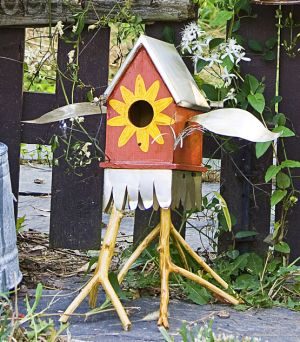If you’re going to grow containers, you might as well grow containers. You know, go all out – make a statement – create a living piece of art! I’m not talking about those little baskets from the garden center filled with the standard petunias, geraniums, impatiens and pansies. Not that there’s anything wrong with those—my kids get me a lovely hanging basket of petunias every Mother’s Day. But if you’re going to invest in good soil, cool pots and unique plants, then you might as well be distinctive, daring and dramatic. In short, it’s time to go big or go home. We’ve got tips to make all your container garden ideas amazing!
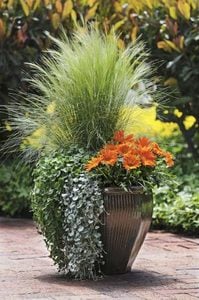
Find the Right Base. To anchor everything, you need the right container. You’ll certainly have plenty to choose from. Just go to the garden center, and chances are you’ll find rows and rows of them in every size, shape and color imaginable. Before you even start looking at plants, find a container that inspires you. A short, stocky container would be just the thing for a small conifer. A bold turquoise container would be the perfect backdrop for various shades of pink. A big, tall container is a nice option for trailing plants.
A good pot or other planter can be expensive, but go ahead and splurge a little if you find one you really like. Chances are you’ll have it for years. Oh, and remember that containers are like shoes—they’re better when you buy them in pairs!
Celebrate Height. One of the easiest ways to make an impact with a container is tall plants. Cannas, purple millet and ornamental corn all have big, interesting leaves—and you can’t beat the wow factor of a cultivar that’s 4 to 6 feet tall. Another easy way to get height is with ornamental grasses. They not only grow several feet tall in a single season, they also give containers nice texture. You can find some colorful annuals (purple fountaingrass, for instance, is an annual in most zones), but don’t overlook perennials like switchgrass and zebragrass. Just because you’re growing in a container doesn’t mean you have to dump the plants out each year. Offer the perennials good protection in a weatherproof pot over the winter, and you’ll have a jump on next year.
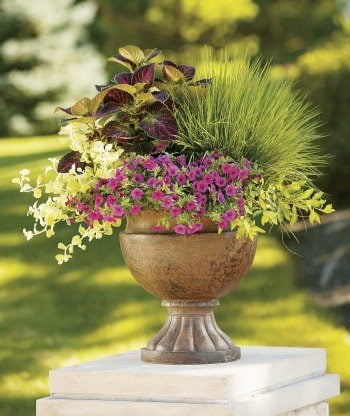
Include Trailing Plants. Trailing plants are a must-have for hanging baskets, but they’re also a showstopper for other containers. Garden centers often have a whole section of trailing plants. Use blooms like trailing begonias, petunias and geraniums, or try foliage plants like sweet potato vine and licorice vine. You’ll probably want to stick to a single type of trailing plant per container, but it can be fun to mix in a couple of varieties within a single family. Plant a couple of sweet potato vines, a standard one and a variegated one. They’ll complement one another while offering some extra variety.
Choose Bold Colors. You don’t necessarily want to pair bright red flowers with a bright red container. But with a little bit of planning, you can use color to your advantage. It starts with your pot of choice. How colorful is it? If you love bright orange, yellow or blue pots, what’ll work well as accents? Another option is to choose a more subdued, neutral pot that maybe has an interesting shape or lines. Then use plants to make an impact. One advantage to this is that you can change the plants from one year to the next. If you have a brown or terra-cotta pot, you could have a red, white and blue theme one year and a yellow theme the next.
The More the Merrier. If you read the label on most cultivars, it’s going to say you should space plants 12 to 24 inches apart. But container gardening doesn’t abide by those rules. It’s better to throw a few extras into the mix, which results in a fuller, bigger, bolder container. Of course, you can go overboard, so use your discretion when planting. If it feels too crowded, it probably is. But if you have lots of soil space, fill it up.
Don’t Forget About Presentation. So you have your height and your trailing plants. You’ve chosen an inspiring container. And you’ve used color to your advantage. Now you just need to make sure that everything works together. Where will your container live? What do you have planted around it? If it’s in a solitary location, is it big enough to fill up the space? The planning and placement of your container are the deciding factors in its success. Give it an outstanding display, and all your hard work will be worthwhile.
Now that you know the basics, use these container garden ideas as inspiration.
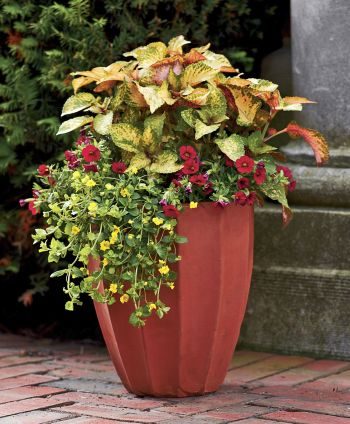
Orange Surprise, by Ball Horticultural
Container Size: 14 inches, Exposure: Sun
- New Day™ Clear Orange gazania (2)
- Emerald Falls dichondra (2)
- Silver Falls™ dichondra
- Pony Tails Mexican feather grass
Container size: 14 inches
Exposure: sun
Party of Five, by Proven Winners
Container Size: 24 inches, Exposure: Sun
- Superbells® Pink calibrachoa
- Northern Lights tufted hairgrass
- Gold Mound duranta
- Lemon Licorice licorice plant
- ColorBlaze® Kingswood Torch coleus
Bands of Gold, by Proven Winners
Container Size: 14 inches, Exposure: Sun
- Superbells® Red calibrachoa
- GoldDust™ mecardonia
- Amora coleus
When we think of health care, we often look within the walls of hospitals and clinics. But what grows just outside some of those walls promotes healing, too. We’re talking about roses that restore, hydrangeas that bloom with hope and salvia that smell of solace. These natural aids to wellness grow in the healing garden plants that many medical facilities today are growing and tending.
Marni Barnes, a landscape architect who designs and consults on the creation of such landscapes, puts healing gardens in two categories: restorative and enabling. “Restorative gardens are designed to provide benefits to people who are simply in the space or able to look out at the space,” says Marni, author of the book Healing Gardens: Therapeutic Benefits and Design Recommendations. “These gardens provide respite, which bolsters our internal healing mechanisms. Enabling gardens provide therapeutic benefit to people who are actively engaged in tending or harvesting the plants that grow there.”
A dose of nature: Why birding will boost your mental health.
Ronald McDonald House Secret Garden
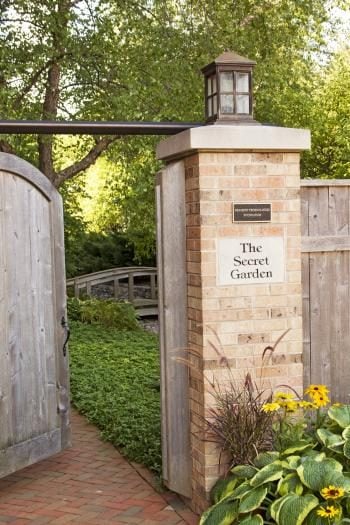
Designing a healing garden means recognizing the physical, psychological, social and spiritual needs of different kinds of patients, such as children or the elderly. Take the Ronald McDonald House of Eastern Wisconsin, which offers short- and long-term residence to families with children seeking treatment for injuries or illness at nearby hospitals. For these families, the house literally becomes a home away from home. And the lush Secret Garden, appropriately named after the children’s book, tucked just behind the building? That’s their backyard.
Planted in 2002, this half-acre organic garden features hundreds of labeled plants that stimulate the senses in some way. Visitors to the four-season garden can play board games in the pagoda, climb on the big wooden play set, meander through the colorful Alphabet Garden or stumble upon the miniature Fairy Garden. “It’s a place for parents to go and reflect, re-energize and meditate,” says staffer Jacquelyn Wahlberg. “For the children, it provides an outlet for their energy, smiles and laughs, and a sense of normalcy.”
Other features are pathways paved with wheelchair- and stroller-friendly crushed gravel. There’s a council circle surrounded by fragrant roses, where families can gather to pray or talk. A large water feature is shallow enough for small children to safely play near. Also look for a produce garden where sun-kissed Japanese eggplant, cherry tomatoes and a variety of fresh herbs grow in raised beds.
“When you come through the garden gate, you’re greeted with a sense of harmony and peace,” says Ann Philips, lead gardener and one of the 16 volunteer University of Wisconsin Extension Master Gardeners who help tend the garden. “We purposely repeated several plant families to give the garden continuity, but also provided some surprises to stimulate the imagination. As I always say to our families, ‘Whatever you’re looking for, you’ll find it in the Secret Garden.’ ”
The garden is also a certified National Wildlife Federation Backyard Habitat. It welcomes butterflies and birds and emphasizes native plants, such as butterfly weed, columbine, purple coneflower and river birch.
Alzheimer’s Gardens
Children and their families aren’t the only ones who are able to reconnect with their roots in a healing garden. More and more, therapy gardens are being incorporated into landscapes that support an aging population, such as retirement homes or facilities that specialize in Alzheimer’s or dementia care.
“In Alzheimer’s facilities, enhancing memory and supporting visits from family and friends are the main goals,” says Marni. “Plants that are familiar, especially fragrant ones, are helpful in triggering memories. Signs with interesting information or literary quotes can stimulate conversation, and a path for residents to pace is important during the middle stages of dementia.”
Alzheimer’s gardens are often enclosed to provide a sense of security. They feature wide, level pathways or labyrinths, nonglare surfaces, social spaces, benches where patients can rest and familiar features like wind chimes, clotheslines and bird baths.
How to Choose Healing Garden Plants
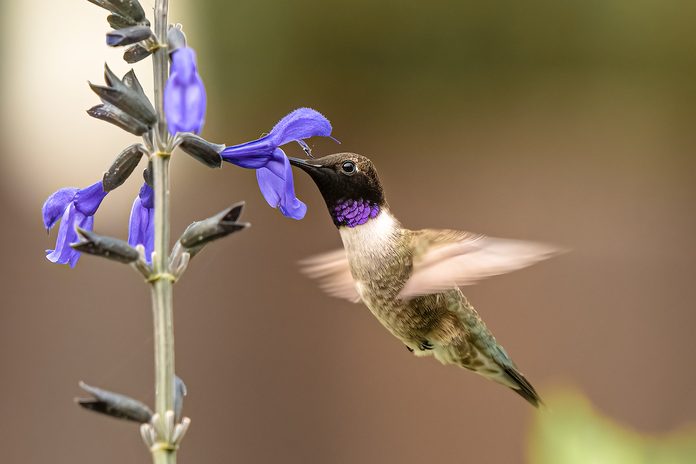
When starting a healing garden, plant selection is key. But the options can be overwhelming.
“Choose healing garden plants that command awareness, either through their own characteristics or because they attract wildlife,” suggests Marni. “The best plants are ones that stimulate the senses and lift a person out of their worries and into the present moment.”
Marni’s personal favorites are ornamental grasses that sway in the wind, bringing attention to a soft breeze. Or tall bamboo — its foliage becomes iridescent when backlit and can bring light into a shady courtyardy. It also makes a soft clacking sound in the wind.
“Try plants that have an intricate or delicate flower, such as fuchsia or snapdragon,” says Marni. “They can draw one into their miniature world. Salvia and sage have great color, their foliage is pungent when crushed, and they attract hummingbirds and butterflies. And trees with interesting bark can prompt one to reach out and touch it.”
Especially in an Alzheimer’s garden, choose plants that trigger positive emotions from a person’s past, such as old-fashioned hollyhocks, lavender or lilacs. Even herbs may help elicit memories of Sunday dinners gone by.
Healing gardens prove that one should never underestimate the restorative power of nature. It connects us, it heals us, and it awakens memories or provides new and happier ones in times of trouble.
Ready to create personalized gift baskets for the nature lovers in your life? Use our tips to build perfect presents for everyone on your list!
Know Your Recipient. It sounds like obvious advice, but it really is essential. Do a little digging and ask the special people on your gift list a few questions so you can really customize their presents. Knowing that someone loves gardening isn’t quite enough. Does he prefer annuals or perennials? Does she do a lot of container gardening? Are they trying to attract hummingbirds and butterflies? Finding out what they’re most interested in will help you dig around and create something sure to please.
Include a Book. Once you have a clear angle or theme for your gift basket, let a good book take it from there. Look at the gardening and nature section at any bookstore, and you’ll find dozens of options. For gardeners, you might find books on planting in containers or attracting -butterflies. For birders, you may discover books on photography or feeding the birds. Once you have the book, take a peek inside for tips and ideas. You might find ideas that you never would’ve thought to put in the basket. Or if the book happens to include projects, you may be able to buy your recipient the supplies needed to make one.
Find Your Basket. You can go with a traditional gift basket if you want (you can often find one for next to nothing at Goodwill), but challenge yourself to think outside the box. While we used a large terra-cotta pot to hold our Garden Guru package, you might want to try a garden apron, a hat or some other imaginative, decorative container. Aim to make everything in the package useful in some way. If you plan thoughtfully, you can make sure your recipient will be able to use or reuse everything in the gift.
Mix Essentials with Extras. If you’re going to put together a Hummingbird Fan package, a sugar-water feeder of some sort is a basic. But be sure to include some extras, too—a brush to clean the feeder or even a bag of sugar. We like to add seed packets to our gift packs because they’re inexpensive yet useful. Do a little research on what seeds are best for feeding birds, attracting butterflies and so on.
Make It Interactive. This is the fun part—figuring out something that will get your recipient really involved. For all the packages here, we include a recipe of some sort, whether it’s for suet, sugar water, butterfly nectar or something else. But be as inventive as you want. If you’re putting together a gift for a crafty person, find a cool DIY project to make on his or her own. For creative gardeners, find a beautiful container recipe they can plant in spring. Another idea: If you’re giving the gift to someone you’re close to, offer to help out. You could include a coupon for weeding, planting or just shopping together at the garden center. What a special way for the recipient to get even more out of the present.
Make It Personal. Anything you can do to personalize your gift will mean a lot to the recipient. Use exterior paint to add a name to a garden container or bird feeder. If your recipient really likes owls, cardinals or monarch butterflies, look for stickers or stencils to embellish the present. Are you good at embroidery or other kinds of sewing? Add a name or monogram to a pair of gardening gloves or garden towel. Even if you don’t have the skills yourself, ask a friend, or pay someone on etsy.com to help out.
Dress It Up. Here’s your final task: Make it pretty! You’ve taken the time and effort to gather wonderful items, so now add the finishing touches. For instance, packaging birdseed in -attractive bags will go a long way in presentation. If the decorations can be reused, that’s even better. Brighten up the hummingbird package with a red bow that can hang on the sugar-water feeder later; to a hummingbird, the more red, the better. Or find decorative pins, buttons or magnets to dress up the garden or butterfly pack. These little personal touches make a huge difference! Now you’re ready to get started. Here are some of our favorite DIY gift basket ideas and options to use for inspiration. We pulled in our ultra-talented craft editor, Shalana Frisby, to turn our ideas into gorgeous results, and offer you some tips along the way!
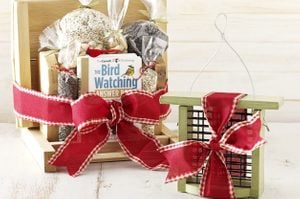 The Bird Lover:
The Bird Lover:
- Safflower seed
- Sunflower seed
- Thistle seed
- Peanuts
- Suet recipe
- Suet feeder
- Log feeder
- Seed feeder
- Game
- T-shirt
- The Bird Watching Answer Book, or another of your choice
TIP: If your items are large or oddly shaped, use an extra-wide wired ribbon to hold items in place and visually tie everything together.
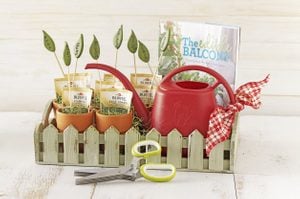 The Herb Grower
The Herb Grower
- Clay pots
- Wooden tray
- Herbs
- Herb seeds
- Watering can
- Soil recipe
- Grow light
- Soil
- Herb cutting shears
- Plant markers
- Herb recipes
- Book – We love The Edible Balcony
TIP: Customize these plant markers any way you like by changing their shape and color. Try a heart, star, moon or other simple shape from a cookie cutter.
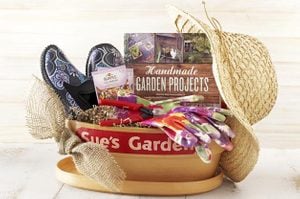 The Garden Guru
The Garden Guru
- Personalized pot
- Soil
- Seeds
- Book (Try Handmade Garden Projects)
- Gardening gloves
- Tools
- Garden shoes and hat
- Coupons
- Garden catalog
- Garden planner
- Magazine subscription
- Container recipe
TIP: Make decorating easy by using premade chipboard letters, stickers, papers or even stamps. Coat your finished creation with a clear waterproof sealer to make it last.
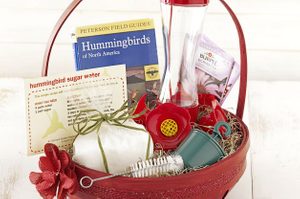 The Hummingbird Fan
The Hummingbird Fan
- Sugar-water feeder
- Sugar
- Cleaning brush
- Ant guard
- Flower seeds
- Sugar-water recipe
- Calendar
- Note cards
- Book (We used A Field Guide to Hummingbirds of North America)
TIP: This basket was originally light pink, but we painted it a deep red. Easily change wood and wicker baskets with acrylic paint or spray paint.
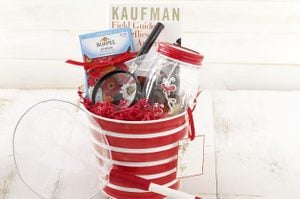 The Butterfly Enthusiast
The Butterfly Enthusiast
- Feeder
- Gardening book
- Sugar-water recipe
- Seeds
- Butterfly net
- Viewing jar
- Magnets
- Guidebook, like Kaufman Field Guide to Butterflies of North America
TIP: This metal bucket will make the perfect leaf- and bug-gathering container for little hands. Throw in a magnifying glass and this DIY net, and you have an excellent gift for a kid.
Looking for a rustic way to mark plants in your garden, or want to create a personalized DIY garden sign? These tree cookie plant marker signs are easy to do, cost very little, and look great in any garden!
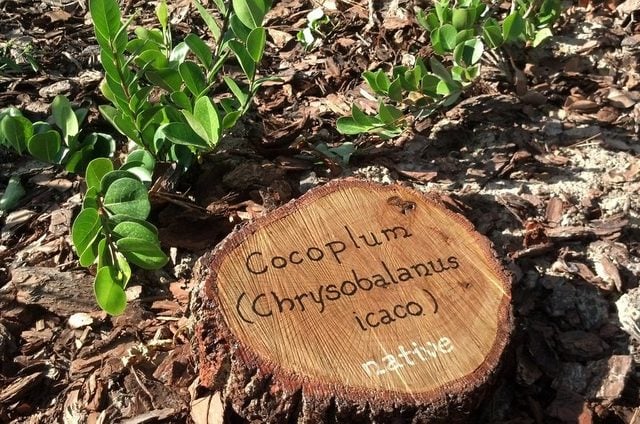
What You Need:
- Tree cookies (see below)
- Medium-Grit Sandpaper
- Paint pen(s) in desired color(s)
- Polycrylic protective finish (or any sealer for use on wood)
- Paintbrush
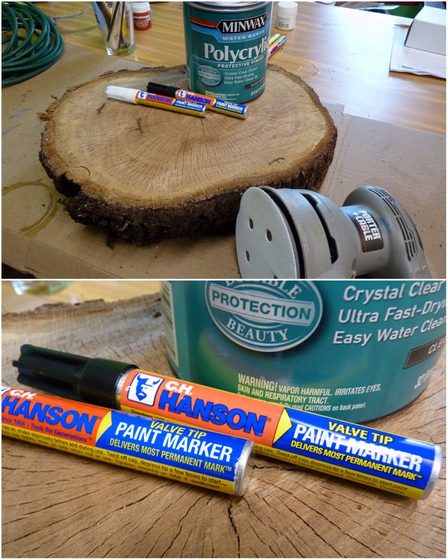
What are Tree Cookies?
Tree cookies are simply flat rounds of wood cut from tree branches or trunks. There’s no need to cut down a living tree – use one that has fallen naturally, or save some branches from pruning. Avoid very resinous trees like pine; birch or oak is best. You can also buy tree cookies at craft stores and online; just do a search for “tree cookies”.
What to Do:
- Begin by sanding the surface of your tree cookie. There’s no need sand both sides unless you plan to decorate both. If you have a power sander available, this process will go much more quickly, especially if you’re doing multiple cookies. Wipe the surface free of debris after sanding.
- If you’re great at lettering or drawing, you can just pick up the paint pen(s) and go to work now, but most of us probably feel better sketching out the text or design first with a pencil and tracing over it with the paint pen. You can also use paint and paintbrushes if you like, but the nice thing about paint pens is that they’re easy enough for anyone to use.
- Once the painted design dries, use a paintbrush to apply two thin coats of polycrylic sealer, allowing it to dry between coats. Allow to dry according to the directions on the can, and you’re done!
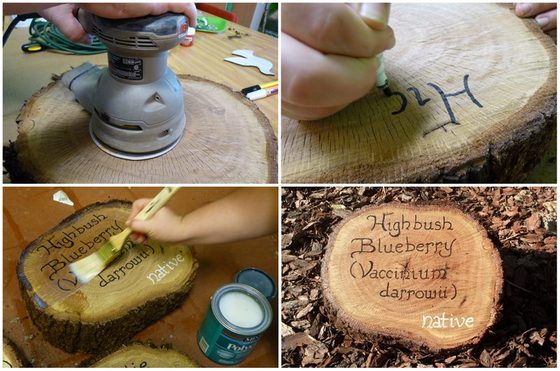
We’re using these tree cookies in the gardens where I work to mark plantings, but you can do just about anything with them. Ours are around 8 inches in diameter and 2 inches thick, but you can cut yours to any size that works for you, including smaller ones to mark seed beds or decorate potted plants. TIP: Smaller ones make great DIY garden gifts and even Christmas tree ornaments!
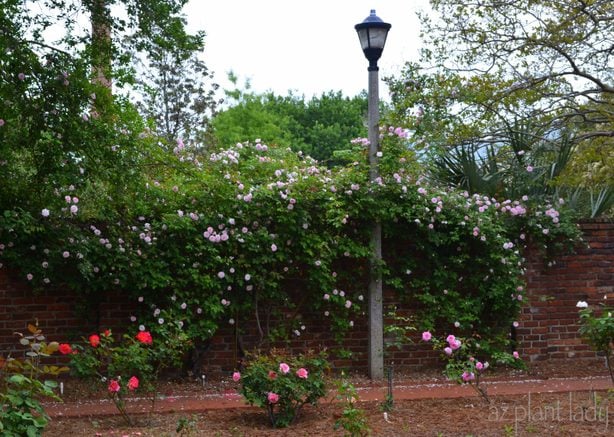
Is the view out your window looking rather barren to you? Dress up your bare wall or fence with beautiful plants! This old, brick wall gorgeous with these roses climbing on it. Unfortunately, not all garden fences or walls are attractive to look at. This is why it good for gardeners to know the best plants to grow against a fence.
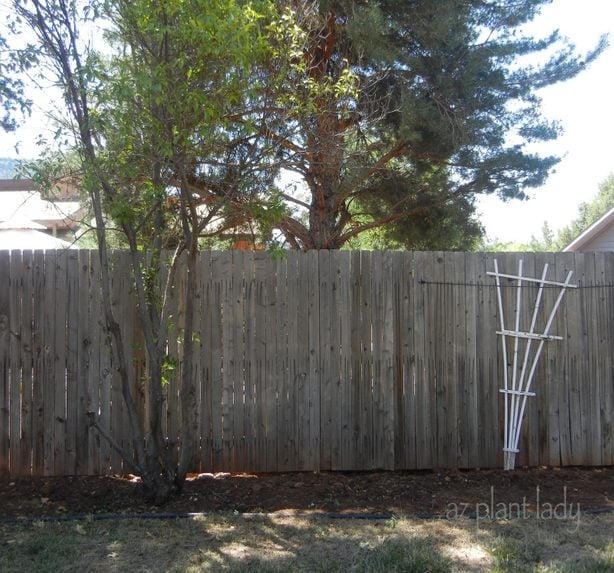
Maybe you have a bare wall that you view from your window. Or maybe your garden is surrounded by a wooden fence. Whether you have a wall or fence, you don’t have to settle for viewing a rather boring expanse. It is quite simple to dress up these bare spaces using plants planted in the ground or in containers. Painting a fence or wall is also great way to add color to your garden.
Best Plants to Grow Against a Fence
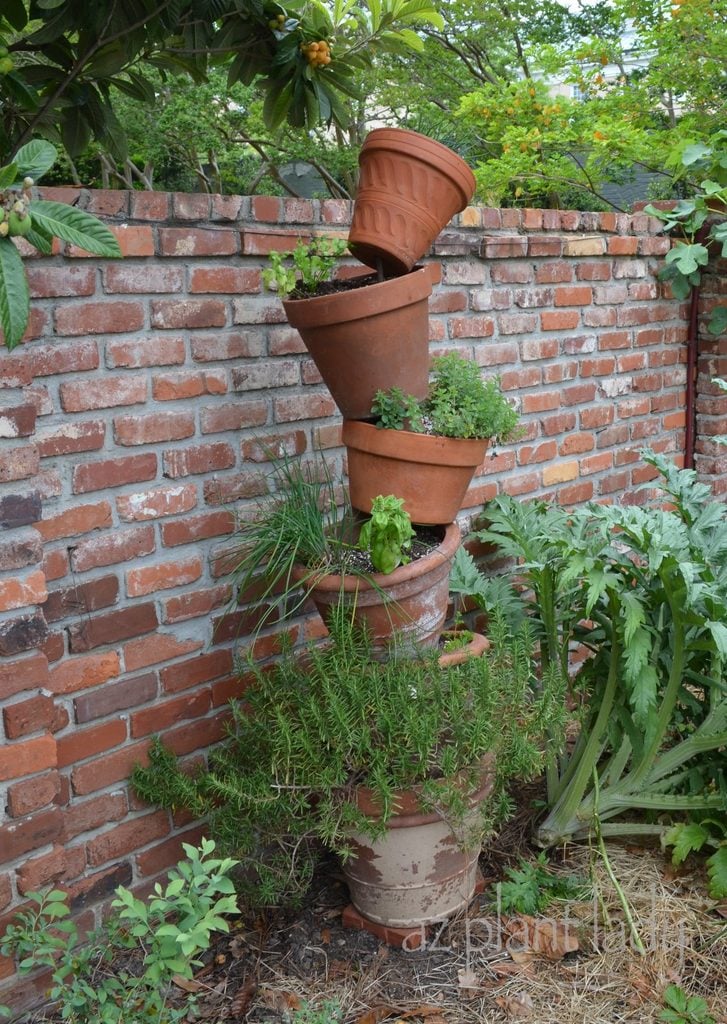
This simple ‘tipsy pot plant tower‘, located at the University of South Carolina is filled with herbs. Next to it is an artichoke plant, which not only produces delicious artichokes—it is also often grown as an ornamental plant.
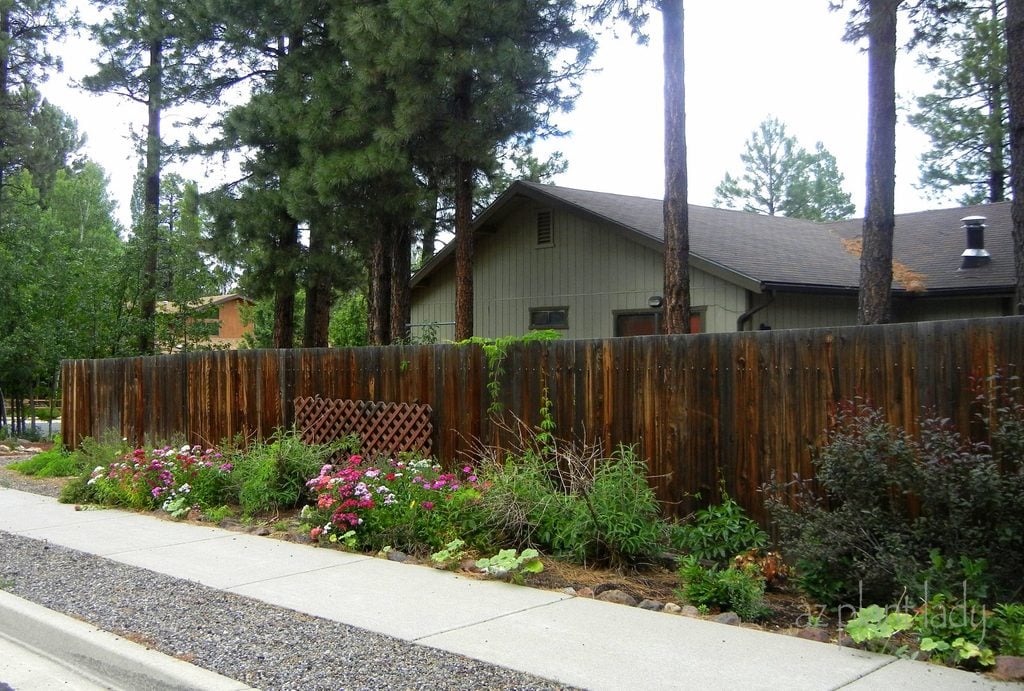
Perennials are a great way to beautify a bare fence, like this garden in Flagstaff, Arizona. Select perennials that do well in your area and pair with ornamental grass and plants that will provide fall color.
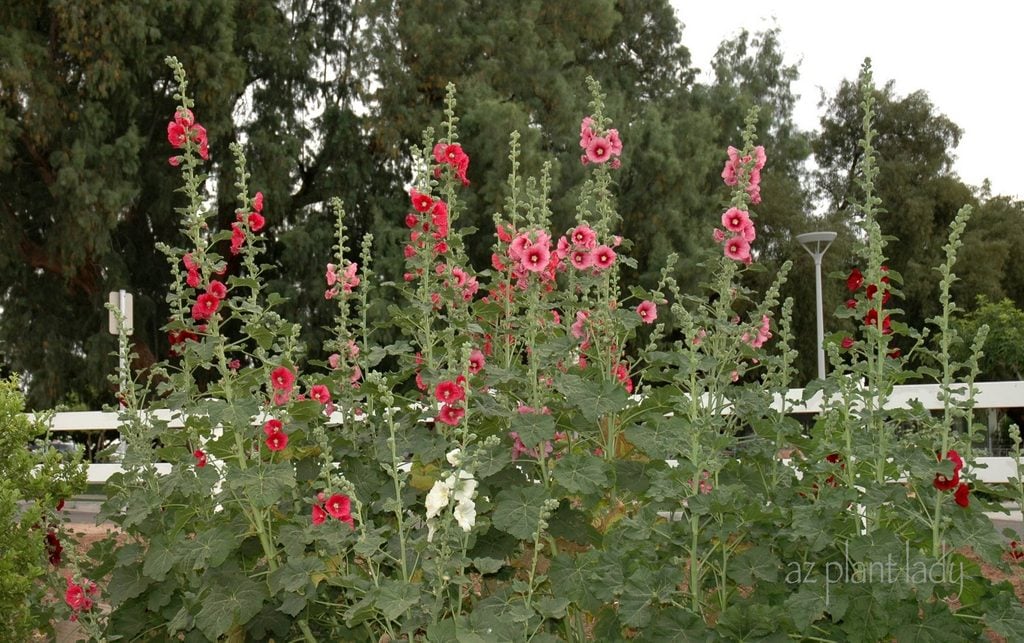
Tall-growing biennials like hollyhocks provide a colorful screen against a fence all summer long.
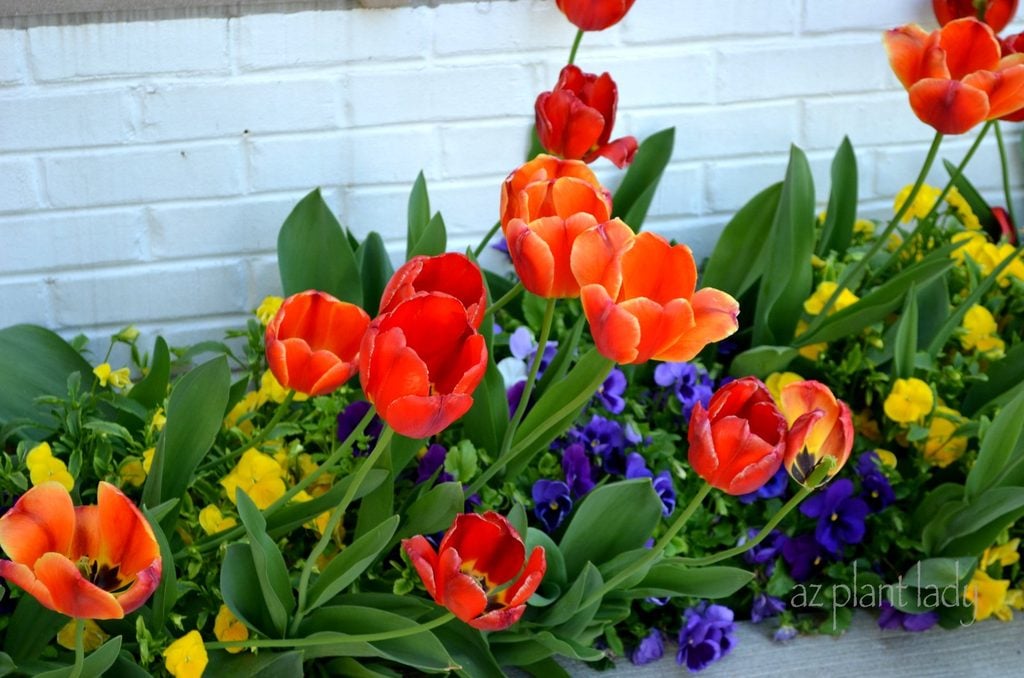
This colorful planting against a bare wall creates a colorful spring display in Berea, Kentucky. Include tulips, violas and pansies.
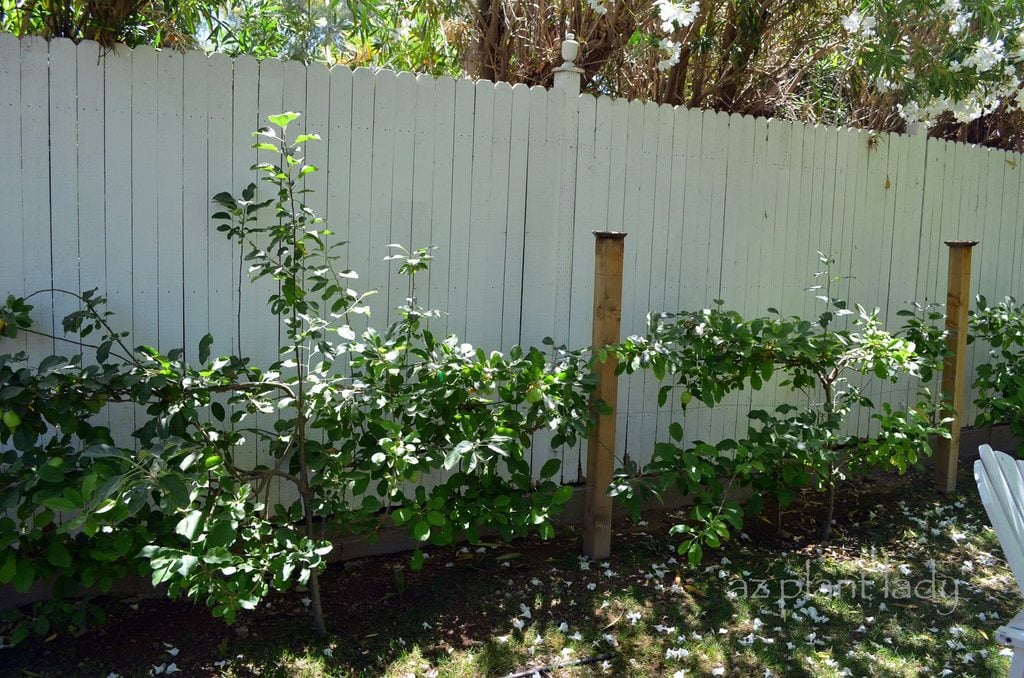
Espaliered fruit trees, like this apple tree, not only look great growing against a fence—they also produce delicious fruit!
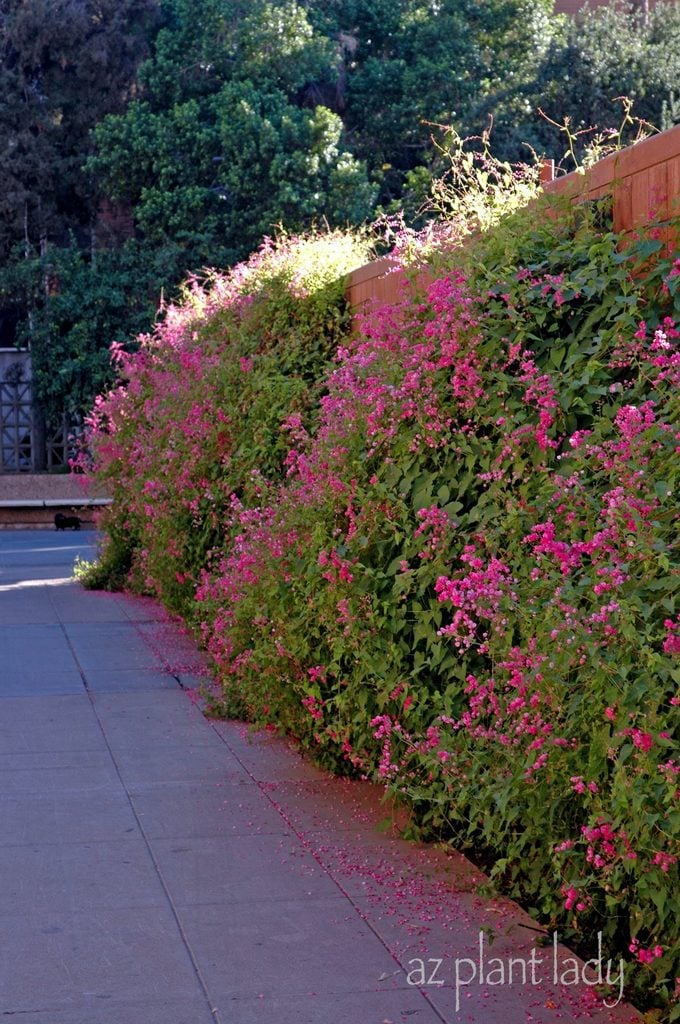
Vines to Grow Against a Fence
Flowering vines are a great choice for bare walls such as this Queen’s Wreath Vine (Antigonon leptopus) at Arizona State University. There are many different types of flowering vines and you are sure to find one that will grow in your climate.
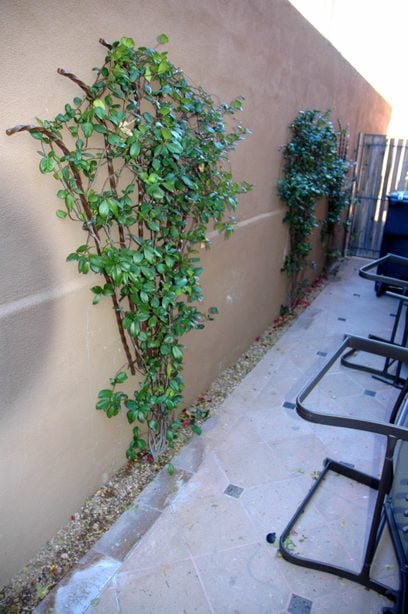
Vines are also a great choice for narrow spots like these star jasmine (Trachelospermum jasminoides) growing up on decorative trellises made up of rebar.
Shrubs to Grow Against a Fence
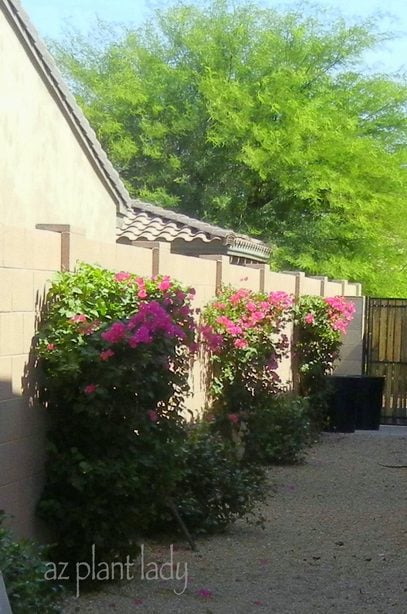
Side yards are often used for storage and utility. This can be quite a depressing view from a window that faces out into this area. An easy solution is to plant a flowering shrub, centered across from each window, like the bougainvillea, above.
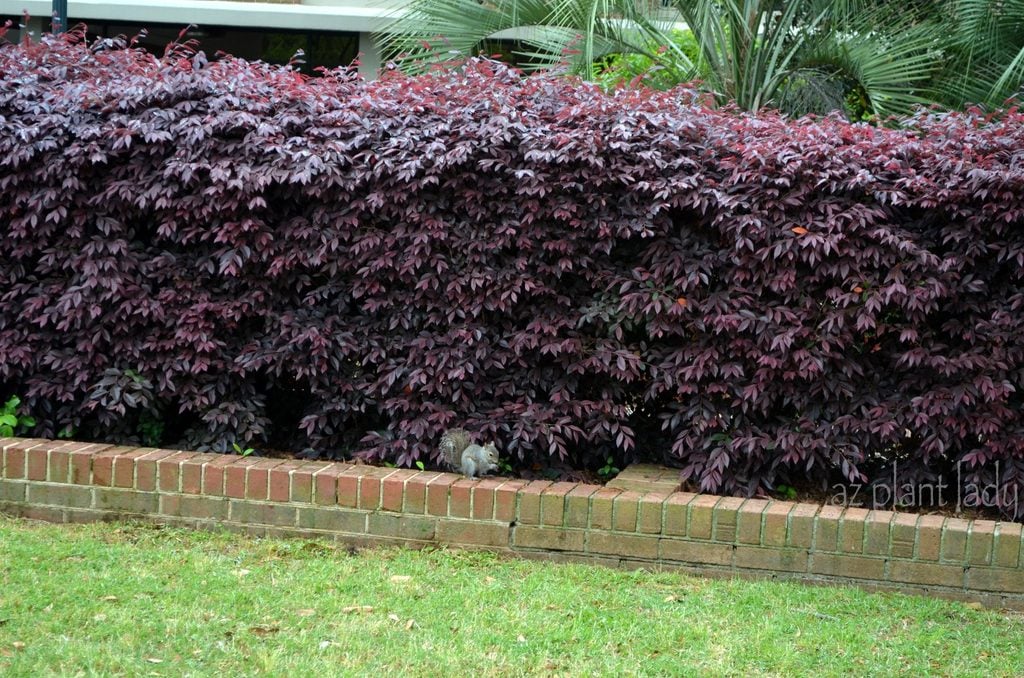
Shrubs with colorful foliage are also a great choice for covering bare walls or fences, like this one at the University of South Carolina.
Container Plants to Place Against a Fence
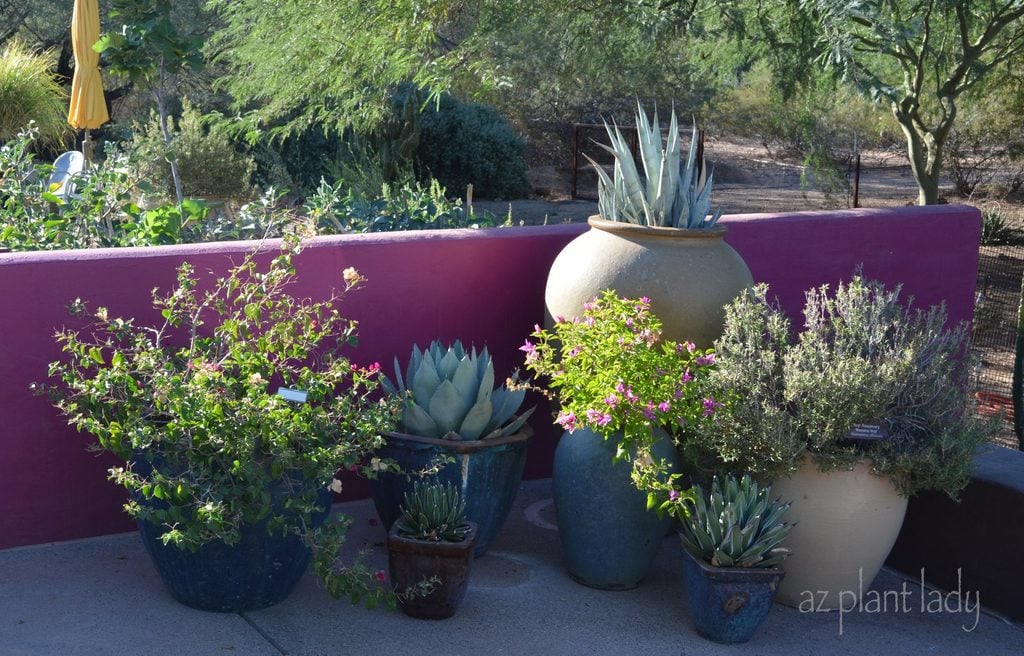
Don’t have soil in which to add plants? Then containers are your best choice. Select a variety of pots and plants for added texture and interest.
Containers mask an unsightly item or block a view. A group of stout containers can hide low-lying items like utilities and hose reels, while taller containers will cover even larger items. Check out 10 dwarf flowering shrubs for containers.
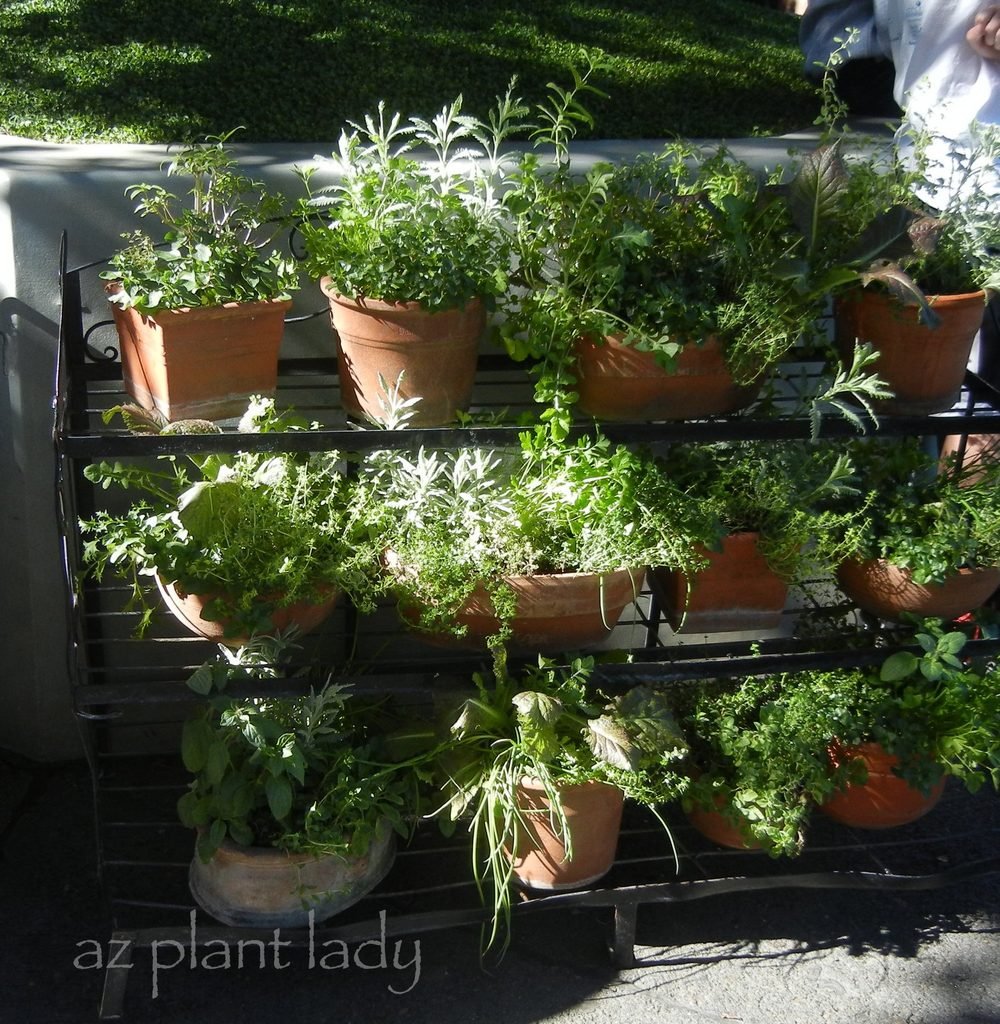
A plant shelf is a wonderful way to decorate a bare wall, like this one filled with potted herbs at Disneyland.
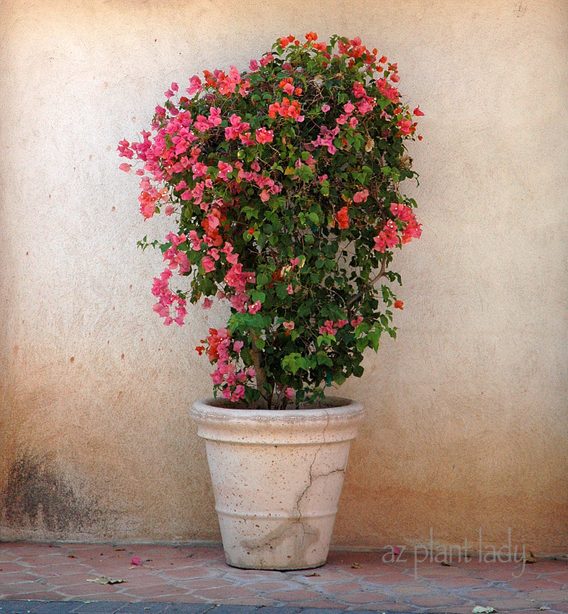
You can grow shrubs against a bare wall, even without soil to plant it in – just use a container instead.
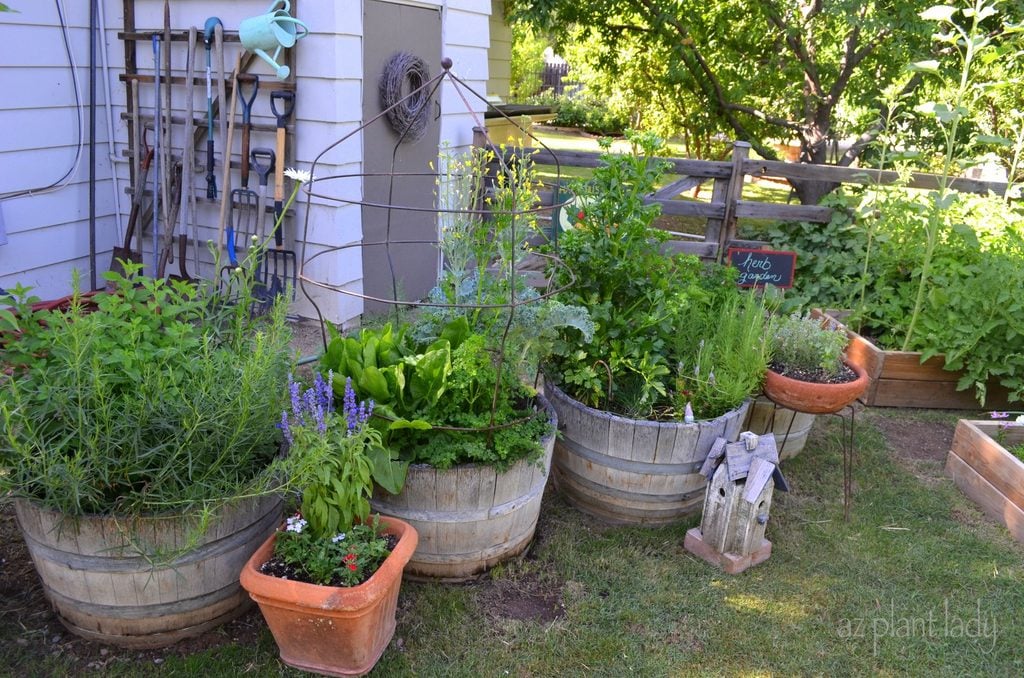
Edible Plants to Grow Against a Fence
Dress up a bare fence with whiskey barrels and fill with edible plants such as herbs and vegetables.
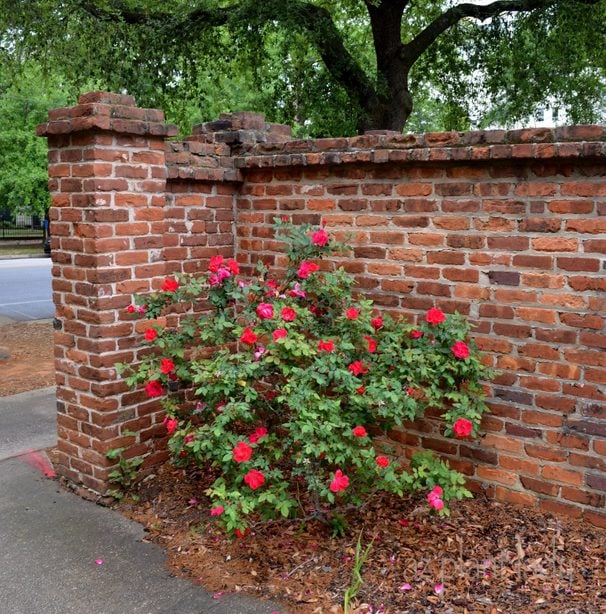
Never underestimate the ability of a single rose bush to dress up a bare corner. Plant a climbing rose to beautify a fence. Or lean a trellis against a structure to create a wall of blooms. Learn how to choose the best roses for your garden.
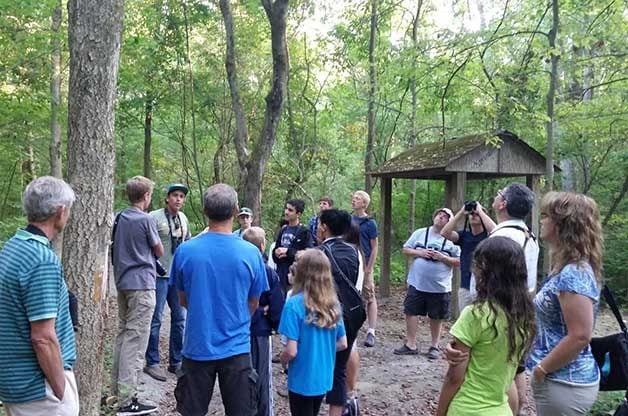
In just a few short days I’m heading to Cape May, New Jersey to attend the Cape May Autumn Bird Festival. I couldn’t be more excited, but my excitement is a tiny bit halted by the daunting task of packing. This is especially difficult when you’re heading off to a whole different part of the country. Here are a few things I’ve learned since going on a few bird-watching trips. And trust me, this is list is as much a help to me as it is you. Hopefully this way, I’ll remember all of these things!
- Print a bird list. A lot of festivals, Audubon societies, etc. will give you bird lists. But just in case, find one online you can print. Plus, if you’re like me, you’ll want to take a look at some of the birds you might see!
- Fashion doesn’t count. Pack for comfort and warmth, especially this time of year. I find that I’ll pack a huge bag full of clothing options, but end up wearing the same comfortable sweatshirt for a couple of days in a row.
- Bring sunscreen. Just because it’s not the heat of the summer, doesn’t mean you can skip the SPF. I learned this the hard way when my hands and face got sunburned while horse back riding in Colorado on a chilly spring day.
- Don’t forget the essentials. The basics are easy to overlook. Make yourself a to-do list and include binoculars, field guide, chargers for electronics, a jacket, warm socks, rain gear. Check out the best birding gear you never knew you needed.
- Check the weather. While a 10-day forecast isn’t always going to be accurate, it doesn’t hurt to look at the forecast for the area you’ll be birding in. That way you’ll have an idea of exactly what type of clothing to bring and if hats and gloves will be necessary.
- Invest in a bird-watching bag. Whether it’s a backpack or cross-body type thing, you’ll want something comfortable to hold water, extra clothing layers, field guides and snacks.
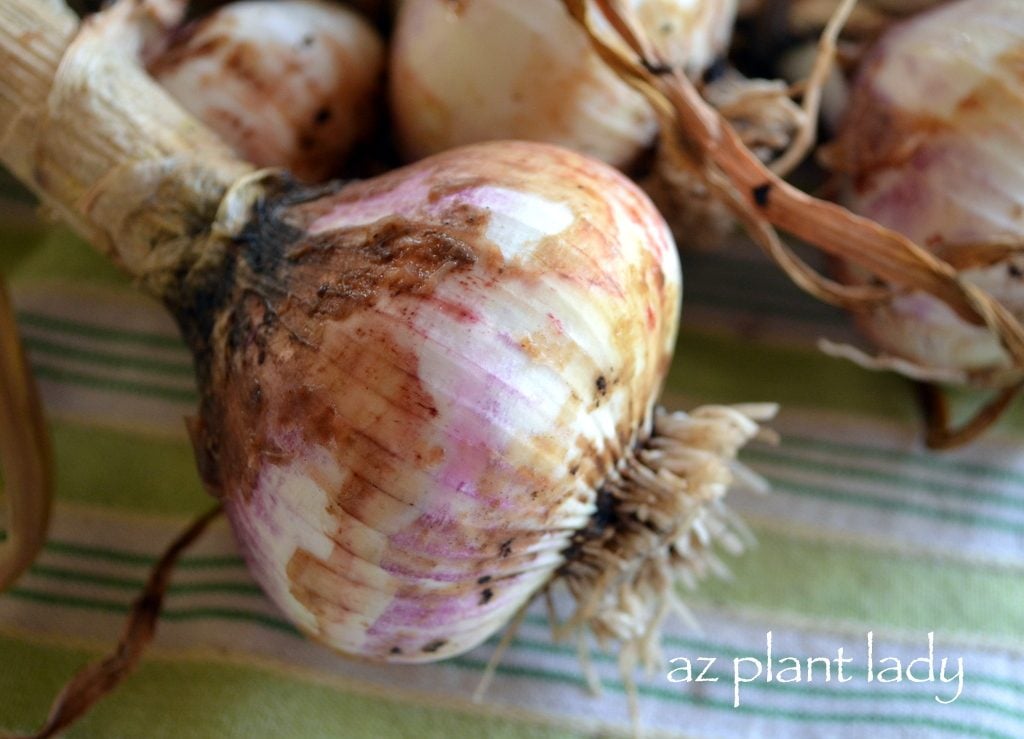
Did you know that planting garlic can keep damaging insects away from your garden? In previous posts, I talked about how garlic helps roses by repelling aphids and help prevent fungal diseases such as blackspot and powdery mildew.
Today, I am going to share with you another way that garlic can help you in the garden. Plant garlic around fruit trees to help prevent borers.
Borers are small beetles that lay their eggs in the crevices of bark. The eggs hatch and the small larvae eat their way into the sapwood of your tree, which causes damage and can even kill a tree. Borers usually target young or drought-stressed fruit trees, although they can go after a healthy tree, too.
Bugs simply don’t like the smell of garlic.

Now, you don’t have to go out and buy fancy garlic from the garden nursery to plant, (although you certainly can if you like). A simple trip to your local supermarket is all you need to do. Plant 5 to 7 garlic cloves around your tree about 1 or 2 inches deep. Keep the papery skins on and plant each clove so that the pointed part faces upward.
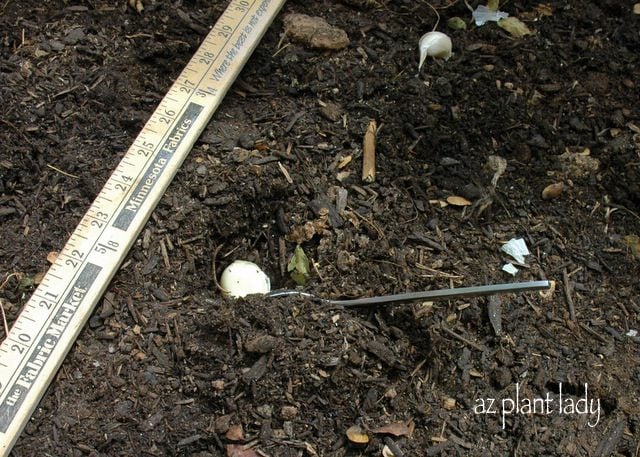
As garlic begins to grow, green shoots will form. You can cut a few and dice them much like you would chives and use them with you cook for a mild garlic flavor. In cold climates, the greens will die back in winter, but will come back in spring. For those of you in warmer climates, the greens will last year round.
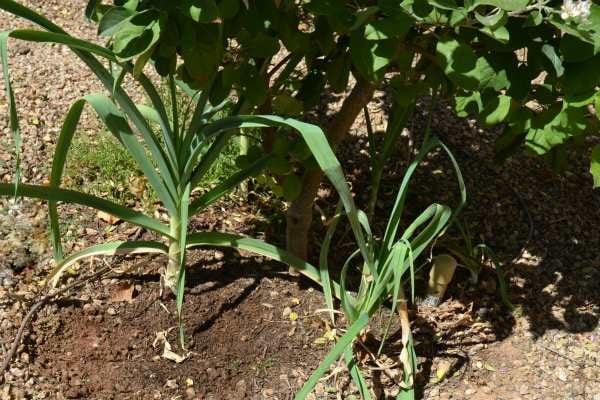
If you have apple, apricot, cherry, nectarine, peach or pear trees, I highly recommend planting garlic around each tree. Garlic is easy to grow and can be grown among existing plants or even in containers.
Even if you do not have fruit trees, growing garlic is fun and rewarding. Fall is the best time to plant your garlic, whether to keep bad bugs away or for eating later. Garlic bulbs last around 6 to 9 months after harvesting.

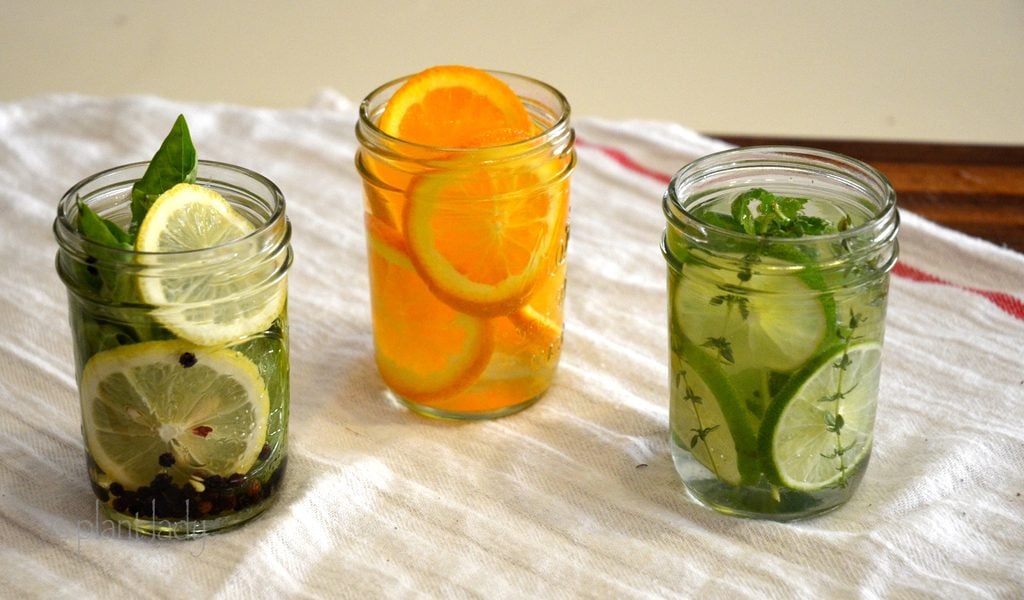
Do you like your home to smell nice and fresh?
What if you could create your own ‘natural’ air fresheners using herbs, fruit and spices instead of spraying artificial scents into the air? There are countless products on the market that claim to freshen up the air in your house. But often, their fragrances are overpowering, artificial smelling and expensive.
Imagine if your home could have the natural fragrance of citrus paired with your favorite herbs. Their fragrance is refreshing and not over-powering. Better yet, they are easy to create with items you may already have in your own kitchen.
Releasing the fragrance is done by adding the contents of your natural air fresheners with enough water to fill a small pot at least 1/2 – 3/4 full. Heat to boiling and then turn down to low and allow it to simmer. That’s it!
You can make up one air freshener at a time, or make a few and freeze them until ready to use. They will keep for at least a week in the refrigerator. Your natural air freshener can also be frozen – just make sure to freeze it in a freezer-safe container such as a wide-mouth jar, like I have.
There are many different fragrant combinations. Here are a few of my favorites:
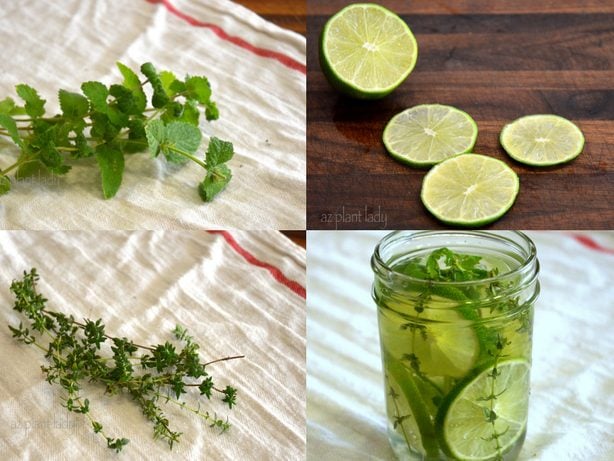
Lime with fresh thyme, mint and vanilla. For this natural air freshener, I cut some fresh thyme and mint from my garden and added a lime that I had sliced. I then added a teaspoon of vanilla extract and filled the rest with water.
That’s all there is to it. I told you it was easy to make DIY air fresheners from natural ingredients!
Here are some other ideas:
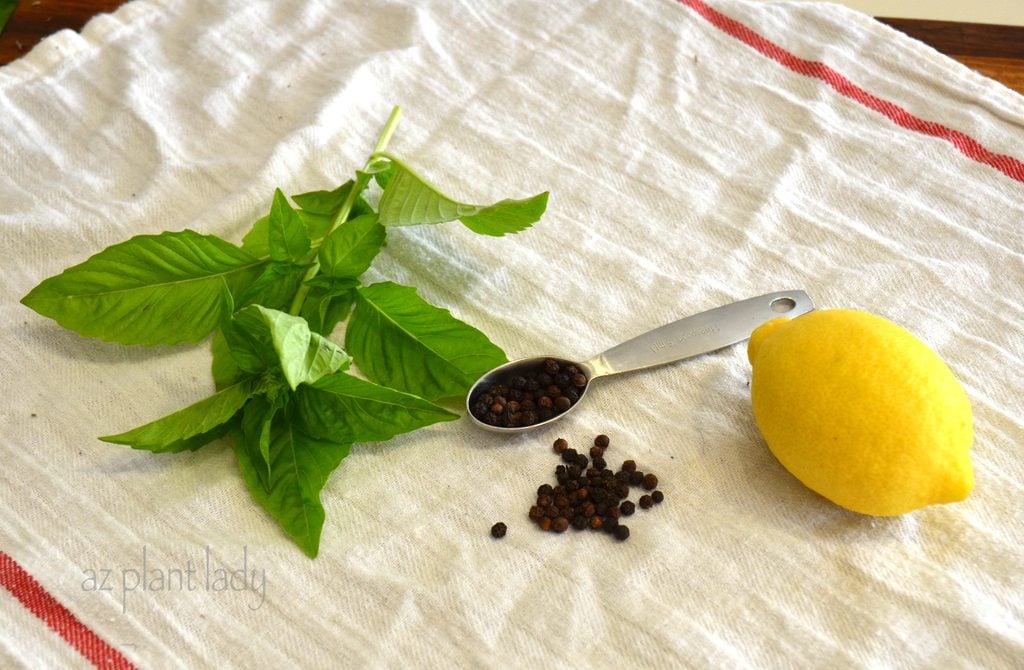
Basil, peppercorns and lemon. This combination reminds me of my childhood in Southern California where we had a large lemon tree. The basil came from my home garden, the lemon from the grocery store and the peppercorns from my pantry.
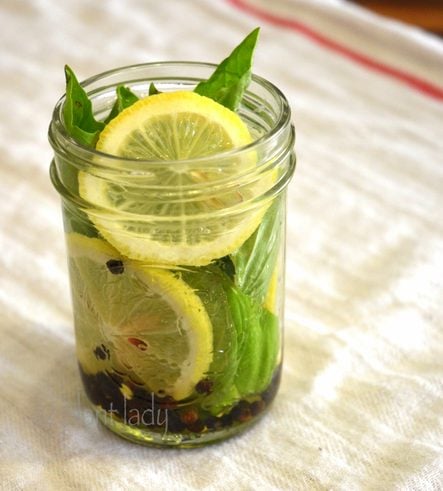
These natural air fresheners aren’t just fragrant, they look great in jars, don’t you think?
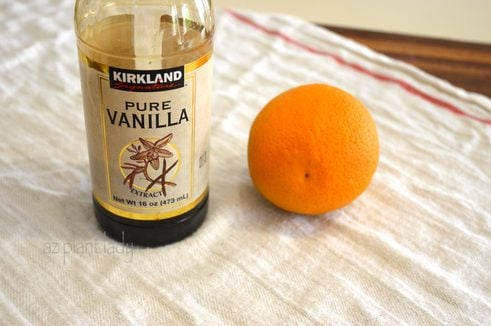
Orange and vanilla. I love this combination because it takes only two ingredients AND it smells like orange sherbet and vanilla ice cream mixed together, which was my favorite ice cream flavor as a child. To create this, simply add a few slices of an orange and 1 teaspoon of vanilla extract. You can add whole cloves and cinnamon sticks to spice the orange and vanilla, if you like.
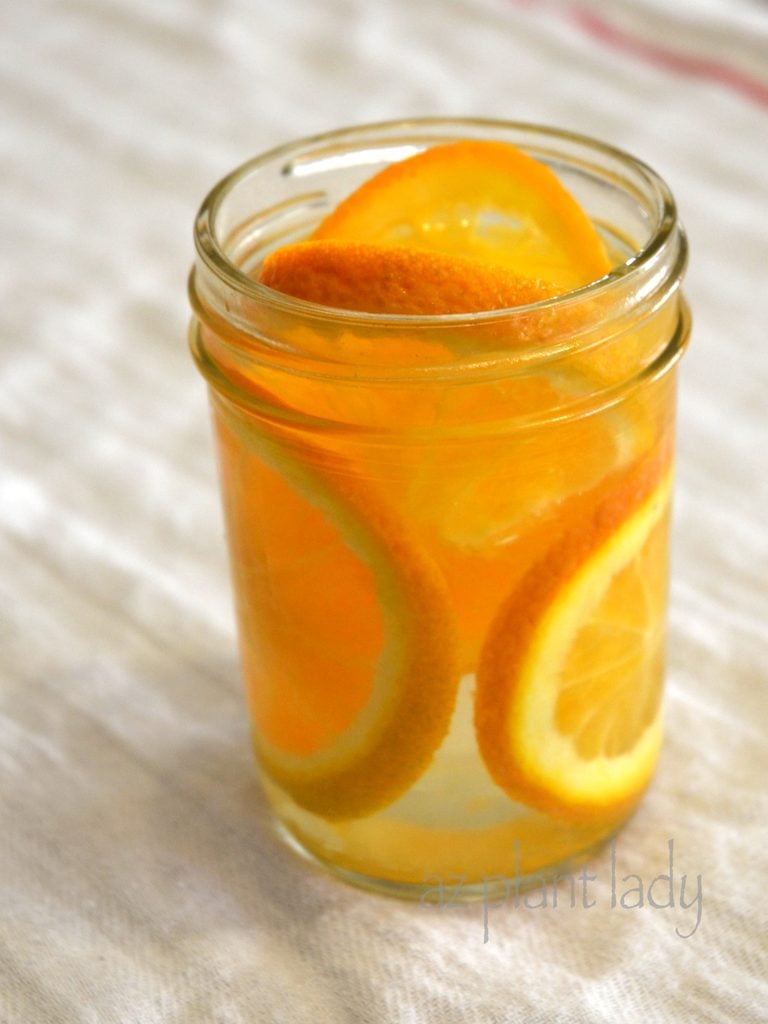
As you can see, making your own natural DIY air fresheners is easy to do. In addition to the fragrant combinations that I have made, you can have fun and create your own combinations. In addition to the ingredients that I have used, here are some others that you can experiment with to create your own unique natural air freshener: citrus peels, apple peels, almond extract, peppermint extract, coconut extract, ginger, nutmeg, ground cinnamon, whole cloves, bay leaves, basil, sage, lavender, oregano and rosemary.
What combinations would you like to make?
Birdhouses are made to be adorned—at least, that’s my philosophy. I love repurposing old knobs, candlesticks and other odds and ends into accessories for birdhouses. I call the finished products “birdtiques,” and they look fantastic in the garden. Best of all, these birdtiques don’t cost a lot of money. All you need are a simple $10 birdhouse kit, a junk pile and a little imagination. Get ready to have the most stylish DIY birdhouse on the block—that is, if you can bear to put it outside.
I think of each DIY birdhouse as having four elements that make it distinctive: the base, the roof, the perches and the predator guards. You can customize each one -depending on the supplies you have on hand.
Bases. Old coat hooks, ceiling light canopies, tree branches, discarded candleholders, antique sink or shower faucet handles, ashtray stands—these and more make wonderful birdhouse bases.
Roofs. Metal, rubber or fabric – use any kind of flexible, water-impervious material as a roof. Even if all you have is a faded scrap of Sunbrella fabric, you can glue it over the roof, seal it and then add moss for a living roof. The birds will love pulling the moss out for their nests!
Predator guards. Predator-guard candidates come in all shapes and sizes. Just adding an inch can keep squirrel and raccoon paws from scooping out the eggs. And even more will protect bluebirds from crows, cats and snakes. When selecting a guard, keep in mind what size hole you need to attract certain birds. You don’t want it too big, or that will assist predators. Old porcelain light sockets, chrome radiator flanges and big rubber gaskets are a few handy options.
Perches. While sweet in appearance, perches give predators a leg up on stealing eggs and disrupting a nest. It’s always best to remove perches from store-bought birdhouses. Instead, think about using a perch on the side of the house, where it will double as a handle. Discarded cabinet knobs, tin wings, and spigot handles from sinks or hose bibs all make interesting side perches.
Psst! Learn how to make a DIY coffee can birdhouse, too.
Materials:
- Birdhouse kit
- Wire
- Base
- Roofing material
- Glue
- Paint
- Sealer
- Accessories (odds and ends, junk, etc.)
- Needle-nose pliers
- Assorted screws, roofing nails, finishing nails
- Cordless drill
- Coping saw (for clean-out door)
- Tin snips or sharp scissors
- Vegetable peeler or paring knife
Step-By-Step Instructions:
Step 1
Assemble and glue the house, excluding the bottom. (You can also recycle an old birdhouse.) Lightly sand and smooth the inside and outside using medium- to fine-grit sandpaper. Pay special attention to the hole where birds enter and exit.
Step 2
Drill holes in the bottom panel of the house for drainage and ventilation. Sand both sides of the bottom with a medium- to fine-grit sandpaper. Add the bottom to your house but don’t glue it yet. It will be easier to attach your base if the bottom stays free.
Step 3
Prime your house with exterior or interior-exterior primer. I like the eco-friendly low-VOC paints. Don’t paint the inside, though: Keep it natural for the birds. After the primer is dry, sand your house lightly with fine-grit paper to prepare the surface for the final coat(s) of paint.
Now attach a base and accessories. Choose your own design, or try one of these for inspiration!
Step 4
Liza
This dainty pink house takes advantage of several workshop castoffs. Coat hooks salvaged from old closets make wonderful birdlike feet, while a piece of orange rubber belting provides a water-impervious cover for the roof. Finally, an old blue spigot handle does double duty as a side perch.
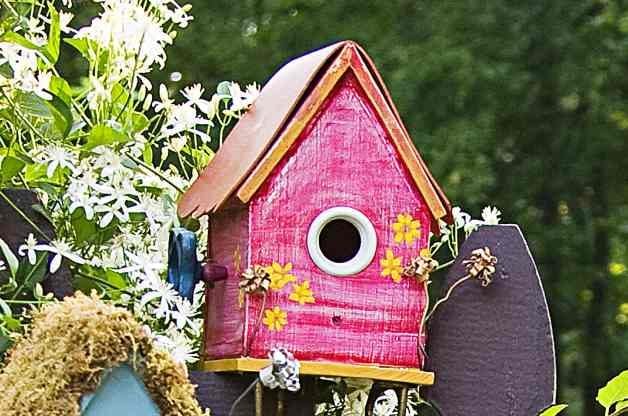
Step 5
Gretel
The base of this Hansel and Gretel house was made out of an iron candlestick, which gives it a bit of panache. Before gluing the bagged moss to the roof, I made sure to fill the roof seam with caulk so little birdies would stay dry. The big, round predator guard lends a modern feel to an otherwise woodland cottage style. The tin flowers provide a delicate birds-only perch, keeping predators at bay.
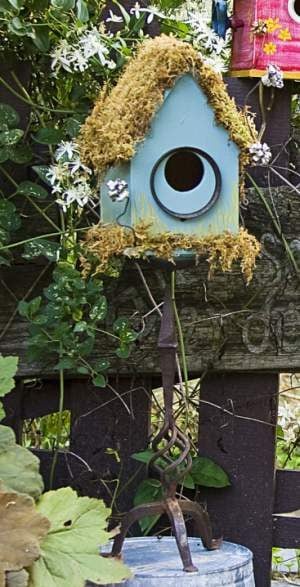
Step 6
Margaret
Margaret is a little more tidy and together. A handsome copper roof, elegant copper flowers and a nicely proportioned light canopy for the base lend an air of refinement. I tinted the final coat of shellac to lend an antique quality to the finish. The front perch is a wooden button that’s dainty enough for a bird but not too much to help a squirrel.
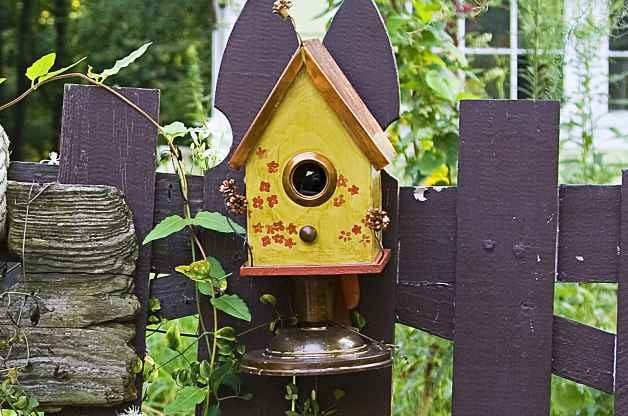
Step 7
Sunny
It’s time to go for a walk in the woods! The legs of this fun house are sticks from the backyard. You can leave the bark on or whittle it away with a vegetable peeler, as shown here. Sunny has roof flashing that is thin and bendable enough to form a roof, wings and “feathers.” The result is a very birdlike house, with the wings doubling as a safe resting spot for feathered friends. Some fun painting and tin flowers add whimsy and color.
